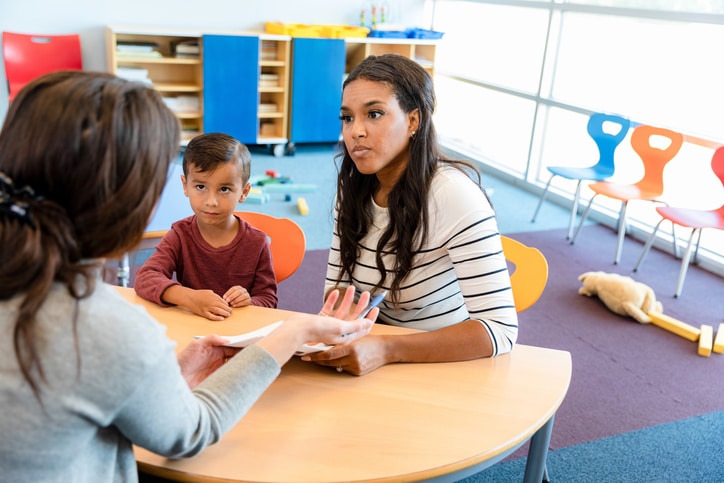Learning differences affect one in five children in the United States. While it’s worrisome to discover your child has unexpected challenges, establishing a diagnosis and getting support is vital to fostering their confidence and love of learning. Luckily, there are some key steps to follow and many resources available to make this process less stressful and ensure both you and your child get the assistance you need.
1. Ask for learning evaluations and support early
Early intervention can make a big difference for kids. That’s why Stacy Turner, the head of school at Hamlin Robinson, a Seattle-based school that serves students with dyslexia and other language-based learning differences, stresses the importance of communication between parents and teachers. If parents suspect a learning difference, they should “start talking with the teacher about the concerns … and then see how well they can partner with the teacher,” he recommends.
The period of time between suspecting a learning difference and getting your child evaluated by an educational psychologist to see if they qualify for an Individualized Education Program (IEP) can be long, especially in public schools. It’s important to be proactive, tenacious and yes, patient.
2. Learn about key educational support resources available in schools
Children with specific learning disabilities are eligible for special education services or accommodations at school under the U.S. Department of Education’s Individuals with Disabilities Education Act (IDEA). This federal anti-discrimination law protects the rights of students with disabilities.
Here are the key support resources to learn about in order to help your child:
What is Child Find?
Child Find is a legal requirement of IDEA, which mandates that each state and its public schools have policies and procedures in place to find and provide special education services to kids. Kids can qualify from birth to age 21 and receive support services for learning and thinking differences, developmental delays and other conditions.
Under Child Find, if a school knows or suspects a child has a disability, that child must be evaluated. All states have early intervention programs for infants and toddlers, and all public K-12 schools have evaluation systems that are designed to cover all children whether they attend public schools or are homeschooled, go to private school, are in migrant families or are unhoused.
What is a 504 plan?
504 plans are named after Section 504 of the Rehabilitation Act of 1973, the civil rights legislation that bans discrimination due to disability. Under Section 504, no one can be denied participation, based on disability, in a program or activity that receives federal funding. Because public schools receive federal money, every child is entitled to a free appropriate public education (FAPE).
Section 504 says schools must evaluate students who might have disabilities at no cost to families. The results of that evaluation help determine whether a student is eligible for accommodations that help support them in school, and a 504 plan lays out those accommodations. Schools can be penalized if they don’t help kids with 504 needs, but they don’t receive any extra federal funding to help accommodate these students.
What is an IEP?
An Individualized Education Program (IEP) is another tool schools use to help ensure students get a free appropriate public education. IEPs are covered under IDEA. In order to qualify for an IEP, a student must have one of 13 specific disabilities listed in the act.
“The IEP is a document that contractually obligates a school to deliver an appropriately calculated education to meet the child’s unique needs.”
— Will Long, special education advocate
Will Long, a special education advocate specializing in IEPs and a member of the disability community explains that “the IEP is a document that contractually obligates a school to deliver an appropriately calculated education to meet the child’s unique needs.”
What is the difference between a 504 plan and an IEP?
While 504 plans and IEPs have the same basic goals, they’re different in a variety of ways. “Both the 504 and IEP are roadmaps for how a school will accommodate the needs of a student,” says Fox. However, an IEP “provides many more protections than the less regulated 504 plan.”
He explains that, unlike a 504 plan, an IEP usually includes services like:
- Speech therapy.
- Counseling.
- Occupational therapy.
- Physical therapy.
- Small-group instruction.
“There are also regular meetings with the IEP team to address goals and concerns, and parents have the right to request additional meetings during the school year,” he adds.
3. Know your child’s rights to testing and support
Ideally, once a child is tested and “relative strengths and weaknesses are identified, schools should hypothetically be able to implement the suggestions,” says Ari Fox, a licensed clinical social worker and the founder and director of Cope With School NYC, a child, adolescent and young adult psychotherapy practice in Manhattan.
Unfortunately, he adds, “schools are overwhelmed and there is a shortage of providers, so children are not receiving services as quickly as they should be.” Fox encourages parents to stay in constant contact with schools to make sure that “they are doing everything in their power to implement the IEP or 504.”
Aileen Weintraub, the author of “Knocked Down: A High Risk Memoir,” who lives in New York and has navigated learning support for her son says, “If you feel you are not getting answers or the school doesn’t feel there is need for testing, it is your right to demand they pay for an independent outside evaluation. That will usually get them to at least do the testing.”
“If you feel you are not getting answers or the school doesn’t feel there is need for testing, it is your right to demand they pay for an independent outside evaluation.”
— Aileen Weintraub, author and parent
You can also have your child assessed privately. “This can be costly,” Fox says, “but there are opportunities in some locations for lower-cost testing through training institutes, clinics and hospital systems.” Parents should also check their employee benefits; some therapies are covered even before receiving an official diagnosis.
4. Document your child’s diagnosis, learning plan and more
As meetings, evaluations and learning plans accrue, keeping good records is key. Fox advises parents to “document all interaction with the school.”
Katie Colt, a Copenhagen writer, musician and parent whose son has undergone several evaluations for different issues at different ages, says, “It’s been a lot of work and required a ton of follow-through on our behalf, but overall, it’s been helpful to have everything documented when working with the school system to develop and establish his IEP.”
Once you have a learning plan in place, it’s best to be upfront with the school and teachers about what your child needs.
| PRO TIP: Create a one-pager summarizing what good support looks like for your student to help the school keep a record of your child’s learning plan and serve as a reminder for teachers. One-pagers can include: your child’s learning style, their needs in classroom settings and their required accommodations. |
5. Be a constant advocate for your child
Sometimes getting schools and teachers to implement the learning plan for your child can be hard, says Lynn Berman, a home visitor for Early Head Start who has also worked in early intervention. “Not because they don’t care,” she adds, “but because they are overwhelmed, short-staffed and under-funded.”
Colt stayed vigilant once her son had a diagnosis to make sure he was getting the recommended support services along the way.
“Keep advocating for your child, and don’t be afraid to be a squeaky wheel.”
— Aileen Weintraub
Weintraub says her son had some great teachers, “but getting them to read and remember his accommodations has occasionally been a challenge.” She explains, “I’ve had to schedule meetings and remind teachers about the legal accommodations required … it’s really something that needs to be discussed at the beginning of every school year, and it’s helpful if a child is involved to the extent that they can remind their teachers.”
“Keep advocating for your child, and don’t be afraid to be a squeaky wheel,” Weintraub adds. When you insist your children receive the tools and accommodations they need to thrive, you set them up for success for the rest of their lives. This also empowers kids to “advocate for themselves as they grow older,” Fox says.
6. Find community among parents
When grappling with a learning difference diagnosis, finding a community to help support you is so important, Colt says. “It’s easy to feel isolated, especially if you don’t know others who have struggled to get their kids what they need.”
“It’s easy to feel isolated, especially if you don’t know others who have struggled to get their kids what they need.”
— Katie Colt, writer, musician and poet
Berman notes that “schools sometimes attempt to isolate parents under the auspices of protecting privacy — but talking to other parents and dealing with the school professionals as a group can be empowering.”
Weintraub found a local Facebook group that was “a wealth of resources and information.” Heather Schwindt, a dyslexia tutor and advocate, was so frustrated with the offerings for families negotiating dyslexia, she started her own private Facebook group. She also works with Decoding Dyslexia, a grassroots parent-led organization with chapters in every state.
Parents can search Facebook for public support groups like Succeed With Dyslexia and discover local support groups through parents they meet on social media.
7. Connect with education and rights advocates
The Center for Parent Information and Resources offers a state-by-state list of Parent Centers designed to assist families of children from birth to age 26 with disabilities. Parents can find resources there to help them effectively participate in their kids’ education and development and partner with professionals to improve outcomes.
Weintraub encourages parents to reach out to advocacy groups both online and in local communities. Long agrees that hiring an advocate can be helpful. Some community advocates are free and others charge a fee.
“Find that person who will listen and advocate for you.”
— Aileen Weintraub
When her district told her to seek outside paid support, having an advocate was a game changer, says Weintraub. “Find that person who will listen and advocate for you,” she says. She found an advocate on Facebook who was in her region and offered services at no cost. Her advocate “knew the laws in and out,” she explains, and was successful in helping her get the services she needed.
8. Continue learning about ways to support learning differences
There are many resources available for children with learning differences and their families. Here are a few recommendations from the parents and experts featured above:
Advocacy groups and online resources for learning differences
- International Dyslexia Association.
- Attention Deficit Disorder Association.
- Autism Society.
- Literacy resources via FULCRUM.
Books about learning differences
- “Uniquely Human” by Barry M. Prizant.
- “Overcoming Dyslexia” by Dr. Sally Shaywitz.
- “Raising Human Beings” by Ross W. Greene.
- “The Complete IEP Guide: How to Advocate for Your Special Ed Child” by Lawrence M. Siegel.
9. Foster emotional resilience in your child
Therapy is an important resource as well. Fox says a child therapist “can help children and their families understand the challenges a learning difference or attention issue presents, give them tools to cope and can build self-confidence.”
Theresa, a mother of two living in Toronto, whose name has been changed at her request, was pregnant with her second child when she got her son’s autism diagnosis, which she says was traumatic. “I wish I’d gone to therapy when he was first diagnosed so that I could [have worked] out my own feelings more thoroughly at the time and have gotten myself more support…” she says. “It’s very emotional to get a diagnosis. We live in an ableist society, and parents, including myself, have a lot of internalized ableism. I needed to do a lot of learning before I was able to properly see the diagnosis for what it was.”
“What children most need from their parents is love, support and acceptance”
— Lynn Berman, home visitor for Early Head Start
During the early stages of diagnosis and while formulating a learning plan, parents should focus on their kids’ strengths and provide positive reinforcement often. “They should help their child recognize what they do exceptionally well,” Fox says, “and find multiple opportunities for the child to explore these strengths and interests.”
Discovering a learning difference and implementing a plan can feel overwhelming. However, while getting appropriate educational interventions is critical, Berman says, “what children most need from their parents is love, support and acceptance.”





